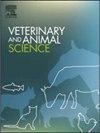Evaluation of camelina seed pods as a novel feed ingredient for ruminants: nutritional value, fermentation characteristics and nutrient digestibility
IF 1.9
Q2 AGRICULTURE, DAIRY & ANIMAL SCIENCE
引用次数: 0
Abstract
This study aimed to assess the chemical composition and nutritional value of camelina seed pods (CSP), as well as to investigate how different inclusion levels influence diet digestibility and in vitro rumen fermentation characteristics. Camelina seed pods were analyzed for their chemical composition and nutritional value, and the results were compared to those of wheat straw (WS) and alfalfa hay (AH). The study further investigated the impact of increasing CSP inclusion levels (0, 80, 160, and 240 g/kg DM) as a forage replacement in the diet on in vitro rumen fermentation parameters. Results revealed that CSP had the highest organic matter (OM) content and the lowest acid detergent fiber (ADF) levels (P < 0.05). Its crude protein and neutral detergent fiber (NDF) content were intermediate between WS and AH. Furthermore, CSP outperformed both WS and AH in terms of ether extract and non-fiber carbohydrate content (P < 0.05). Compared to WS, significantly greater gas production (GP) was observed for CSP at 16, 24, 36, 48, and 72 h of incubation, along with increased total GP and greater GP potential (b). After 24 h of incubation, higher fermentation parameters including in vitro DM (IVDMD) and OM (IVOMD) disappearance, estimated metabolizable energy (ME), microbial protein production (MP), ammonia-N (NH₃-N) concentration, pH, and short-chain fatty acid (SCFA) concentration were observed for CSP compared to WS, but lower than those for AH (P < 0.05). Nevertheless, all GP parameters for CSP remained lower than those observed in AH. Increasing CSP supplementation up to 16 % resulted in a linear improvement in IVOMD, estimated ME, and SCFA production compared to other supplementation levels (L, P < 0.05). The activity of fibrolytic enzymes, including CMCase, increased linearly (L, P < 0.05) with higher levels of CSP in the diet. In summary, the results of this study demonstrate that CSP enhanced in vitro gas production, fermentation characteristics, and nutrient digestibility in comparison to WS. Moreover, several of these parameters were found to be comparable to those of AH.
反刍动物新型饲料原料亚麻荠籽荚的营养价值、发酵特性和养分消化率评价
本试验旨在评估亚麻荠籽荚(CSP)的化学成分和营养价值,并研究不同添加水平对饲粮消化率和体外瘤胃发酵特性的影响。分析了亚麻荠种子荚的化学成分和营养价值,并与小麦秸秆(WS)和苜蓿干草(AH)进行了比较。本试验进一步研究了增加饲粮中CSP添加水平(0、80、160和240 g/kg DM)对瘤胃体外发酵参数的影响。结果表明,CSP的有机质(OM)含量最高,酸性洗涤纤维(ADF)含量最低(P <;0.05)。粗蛋白质和中性洗涤纤维(NDF)含量介于WS和AH之间。此外,CSP在醚提取物和非纤维碳水化合物含量方面优于WS和AH。0.05)。与WS相比,CSP在孵育16、24、36、48和72小时时的产气量(GP)显著增加,总GP增加,GP潜力也更大(b)。孵育24 h后,CSP的体外DM (IVDMD)和OM (IVOMD)消失量、估算代谢能(ME)、微生物蛋白产量(MP)、氨氮(NH₃-N)浓度、pH和短链脂肪酸(SCFA)浓度均高于WS,但低于AH (P <;0.05)。然而,CSP的所有GP参数仍低于AH。与其他补充水平相比,将CSP补充量增加到16%可导致IVOMD,估计ME和SCFA产量的线性改善(L, P和lt;0.05)。包括CMCase在内的纤维分解酶活性呈线性增加(L, P <;0.05),饲粮中CSP水平较高。综上所述,本研究结果表明,与WS相比,CSP提高了体外产气量、发酵特性和营养物质消化率。此外,这些参数中有几个被发现与AH的参数相当。
本文章由计算机程序翻译,如有差异,请以英文原文为准。
求助全文
约1分钟内获得全文
求助全文
来源期刊

Veterinary and Animal Science
Veterinary-Veterinary (all)
CiteScore
3.50
自引率
0.00%
发文量
43
审稿时长
47 days
 求助内容:
求助内容: 应助结果提醒方式:
应助结果提醒方式:


